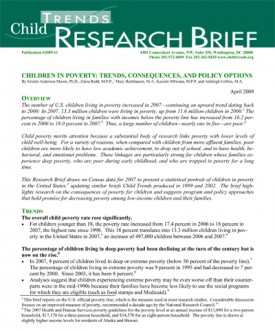The Increasing Child Poverty Rate and Its Impact on Children
Resource type: Research Report
Child Trends |
The number of United States children living in poverty increased in 2007 – continuing an upward trend dating back to 2000, according to this report by Child Trends, which includes recommendations for policy-makers who seek to reduce the rate of child poverty. Child Trends is an Atlantic grantee.
Nearly one out of five children in the United States was living in poverty in 2007, and this percentage has been increasing since 2000. A new Child Trends research brief, Children in Poverty: Trends, Consequences, and Policy Options, uses 2007 Census data to present a statistical portrait of children in poverty in the U.S., updating similar briefs Child Trends produced in 1999 and 2002. The brief also highlights research on the consequences of poverty for children and suggests program and policy approaches that hold promise for decreasing poverty among low-income children and their families.
Among the trends:
- The poverty rate for children younger than 18 increased from 17.4 percent in 2006 to 18 percent in 2007, the highest rate since 1998. This 18 percent translates into 13.3 million children living in poverty in the U.S., an increase of 497,000 children between 2006 and 2007.
- Children are almost twice as likely to be poor as older adults. In 2007, the poverty rate was 9.7 percent for people 65 and older, compared with 18 percent for children younger than 18.
- Substantial racial disparities persist: black and Hispanic children were more than twice as likely to live in poverty in 2007 as non-Hispanic white and Asian children. 34.5 percent of black children and 28.6 percent of Hispanic children lived in poverty in 2007, compared with 10.1 percent of non-Hispanic white children and 12.5 percent of Asian children.
A large body of research links poverty with lower levels of child well-being. Poor children are more likely than children from more affluent families to have low academic achievement, to drop out of school, and to have health, behavioral, and emotional problems.
“Child poverty was a significant and growing social problem even before the current economic recession,” said Kristin Anderson Moore, Ph.D., the lead author of the brief. “Both the statistical data and the research findings cited in this brief underscore the need to resume efforts to reduce the child poverty rate, even as other issues command the nation’s attention.”
RELATED WORK FROM CHILD TRENDS:
- The Well-Being of Children in Working Poor and Other Families: 1997 and 2004 (Child Trends Research Brief)
- Child Care Use by Low-Income Families: Variations Across States (Child Trends Research Brief)
